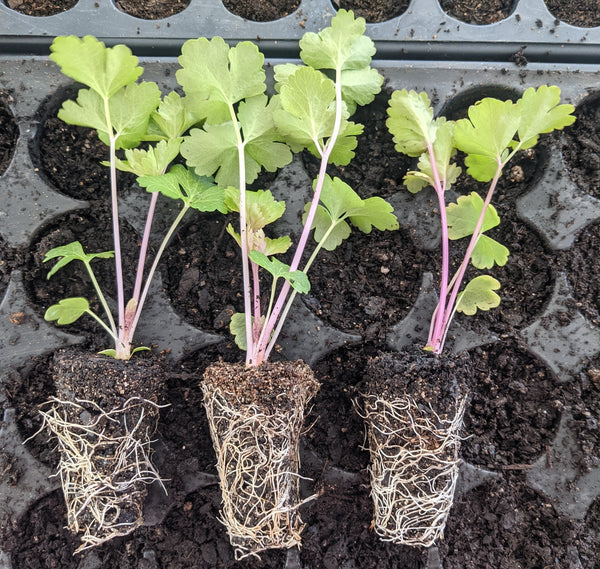Conquering Transplant Shock: A Gardener's Guide to Smooth Plant Transitions
You’ve doted over and nurtured your little plant babies for weeks inside and they’re finally ready to move out.
If you immediately plant them outside, you may be extremely disappointed to find the majority of them die within 24-48 hours. This phenomenon is called transplant shock. Plants do not always die from it, but it can cause intense stress in the plant stunting their growth and leaving them open to attack from pests.
Transplant shock is in essence the plant responding to the extreme change in environment. Going from the most perfect growing environment to the harsh realities of the outside world puts an extreme amount of stress on your seedlings. There are some easy steps you can follow though to help mitigate or completely prevent transplant shock from occurring.
Hardening off

Well-watered collard seedlings outside during their hardening off process
One of the easiest things you can do is put your seedlings through the process of hardening off. This is where you bring your seedlings outside for increasingly longer periods of time over the course of a few days until they are able to tolerate the outdoor environment. A hardening off schedule might look like this:
Day 1: water, place seedlings in deep shade for one to two hours
Day 2: water, deep shade for two to four hours
Day 3: water, light/dappled shade for two hours
Day 4: water, dappled shade in the evening and leave them out overnight
Day 5: water first thing in the morning and let them stay in the dappled shade all day with maybe an hour or so of full sun. Monitor closely and water regularly. Leave out overnight again.
Day 6: They should be ready to try a half day or so in direct sun at this point with watering every two or so hours so their tiny root balls don’t dry out. Repeat for one more day if they wilt at all in the sun.
This process might go faster or slower depending on the type of weather you are experiencing. If the weather is very cloudy and rainy, the process may only take three or so days. If it’s the middle of summer with oppressive heat and humidity, it may take a full seven days.
The important things though are to make sure you do not allow them to dry out, pull them back inside or into deep shade if they begin to wilt, and remember it is important to be patient. It is better to air on the side of caution and overprotection than to rush through this process.
Transplant timing
Whenever possible, choose a day that is overcast or drizzly as your transplant day.
The seedlings will already be going through a tough transition from their cell packs into the ground, so removing the stress of the sun is helpful. If you have nothing but clear skies on the horizon, transplant in the evening so they have roughly 12 hours of nighttime darkness and cooler temperatures to adjust to their new home.
If that’s not an option for you, try to find a way to provide shade for them via shade cloth or a pop-up tent or some other creative way. I will note, the smaller the seedlings, the more necessary this is. The larger and more robust they are, the less necessary the shade is.
Root disturbance and water

If the bed is dry when the moist, happy little seedlings get tucked in, the water’s capillary action will actually cause the water to seep into the surrounding dry soil, causing the seedling to dry out rapidly. When in doubt, water! During the first week or so it is critical to keep those seedlings well watered as they get established in their new home.
When handling the little root balls during transplanting, try to be as gentle as you can in order to prevent the roots from being broken. Again, the smaller the seedling the more important this is. Tiny babies cannot handle a lot of stress whereas larger ones can take a beating and be fine.
When transplanting out plugs from 128 or 72 trays, I like to use my hori hori knife to make a hole just the right size for the plug so I can place it in without the root ball touching the sides of the hole, then gently close the soil around it and firm it into the ground to remove the air pocket. The roots need to be in contact with the soil in order for them to grow into the soil.
Amendments
A final tip for helping seedlings adjust to their new home is through giving them a bit of an extra boost.
Diluted seaweed extract, compost tea, aloe vera, fish emulsion, and water soluble mycorrhizal fungi are all wonderful additions to those early waterings that can help fortify the seedling against stress. The seaweed extract, compost tea, and fish emulsion provide extra nutrition for the seedling to help strengthen it and bolster its immune system, reducing the risk for pests.
The aloe vera and water soluble mycorrhizal fungi help the root systems in different ways. The aloe will help soothe any broken root cells and stimulate new growth. The mycorrhizal fungi will bond with the roots, creating a beneficial, symbiotic relationship that will provide extra water and nutrition to the plant as well as help protect it from parasitic nematodes and the like.
Final thoughts
Experiment! Follow all of these steps and recommendations, or pick and choose and see what works for you. You will still kill plenty of plants (always start more seeds/plants than you will need to help make up for any losses), but don’t let that dissuade you from trying. You’ll get a little better each time.





















